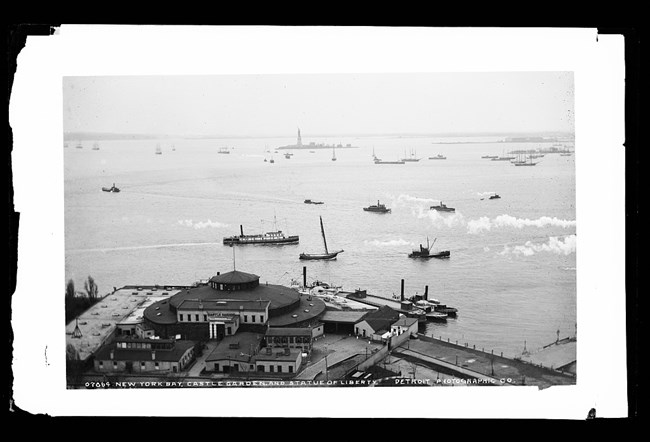
Library of Congress The largest ethnic group that came through the facility were Germans, followed by the Irish, English, Swedish, Italians, Scottish, Russians, Norwegians, Swiss, and French. Today, about 20% of Americans can trace their ancestry to someone who came through Castle Garden. The facility was the first of its kind to take detailed records of the people who passed through its gates. Officials recorded the names of each individual and family, the vessel they arrived in, their destination, the amount of money they had on hand, and even the names of family members already in the United States. Castle Garden provided these new arrivals a safe place to buy railroad tickets, exchange money, contact relatives, rest, and even wash up before leaving. Though most of its original records were destroyed and little of the facility remains, original stories and images of the facility have been preserved in newspapers and other media. Taken together, these records allow historians to pull back the veil of the past and attempt to recreate the first steps of these future Americans in their adopted homeland. Inside Castle Garden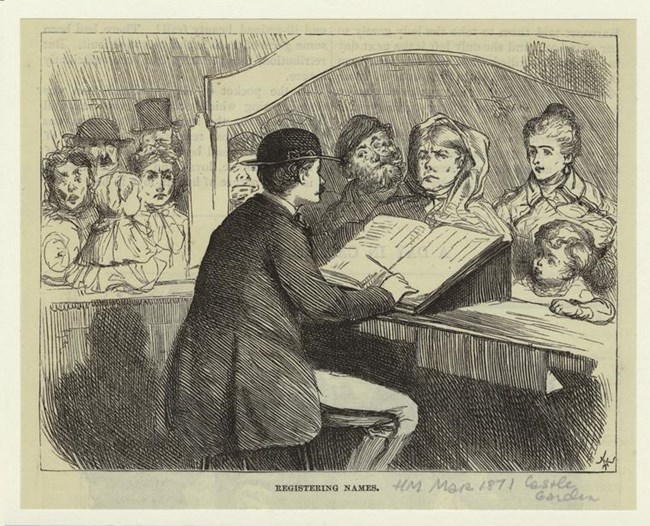
New York Public Library Entering the RotundaThe Castle Garden Rotunda was the large open space directly below the building's roof. This space held the majority of offices located within the depot, as well as the Superintendent's Office on the second floor. It was also the most cramped and crowded space in the entire facility. Upon entering the rotunda, one Norwegian immigrant described the scene as “…so loud that one had to shout into the ear of the listener in order to be heard.” Another said, “The moment I arrived I was met by a violent roar. The immense room was packed by people representing every nationality in the world… Here there was much to listen to, but nothing to understand.” Yiddish-speaking immigrants coined the term "Kesselgarden" to describe the often noisy, confusing and chaotic scene they witnessed as they passed through.The Registry DeskUpon entering the facility, immigrants were separated into two lines and funneled to the registry desk. One line was for those who could speak English, while the other was for those who understood other languages, usually German and French speakers. At the desk, immigrants were required to register by answering questions about themselves and their intentions. To help those who could not understand English, translators knowledgeable with multiple languages were utilized, though communication often proved difficult. One observer noted, “…a young fellow was asked if he were alone. ‘No, Sir,’ he said, boldly; and when asked who was with him, he answered, ‘Sure my box!’ Another wanted to register two game cocks he had brought with him from Tipperary, ‘Sure I paid their passage,’ he said. Still another—an old woman—on being asked her name, said that it was on her box [luggage], ‘and if we wanted to know, sure we could go and see’; and upon being asked by a bystander how, then, her box could be found, her answer was, ‘Ah, be jabers, an’ isn’t me name painted on it?’ With much difficulty her name was finally ascertained.”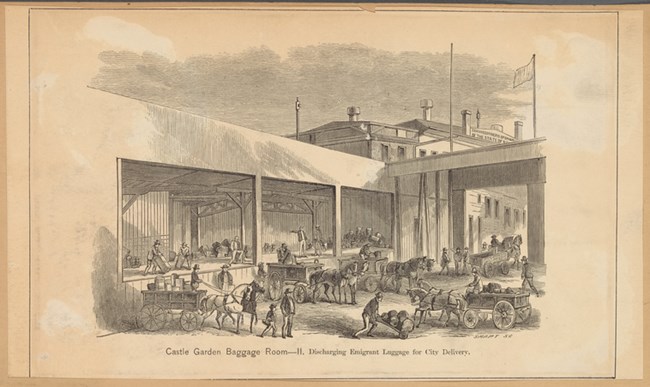
New York Public Library The Baggage DepotWhen Castle Garden first opened in 1855, the processing of immigrants' luggage was haphazard and chaotic. Bags were dumped in an unorganized pile just outside the rotunda. Immigrants were given unrestricted access to the pile to find their luggage, and allegations of theft were common.The space was enlarged in 1857, and a new system of baggage delivery was introduced to prevent future theft. This new building, located off Castle Garden's west side, was 11,393 square feet, and held thirty-eight stalls capable of containing 80 ordinary sized travel bags. The facility allowed for 3,040 packages to be stored at a time. The facility was expanded later in 1869 in order to accommodate 15,000 pieces of baggage.Often, immigrants who arrived at Castle Garden were unable to pay for the tickets necessary to get them to their intended destination. They would usually leave their baggage at the Depot until friends and family could send the proper funds to pay for their travel. This could take days, and immigrants were allowed to store their luggage at the depot for up to six days. Baggage could be sent for and delivered to any place in New York, Brooklyn, Jersey City, Hoboken, or Westchester county. If not in the immediate area, baggage would be loaded onto a steamship and taken to nearby railroad stations for departure. 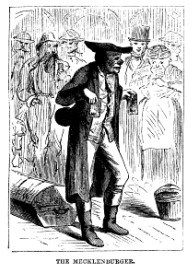
Harper's News Monthly, 1871 The Exchange OfficeThe Exchange Office was a place where immigrants could exchange foreign currency for American money. The office was required to physically post the current exchange rate on Wall Street and update it as the rate changed throughout the day. With the Stock Exchange just a few blocks away, communication between the two was almost instantaneous, and the offered exchange rate would often change suddenly without warning. Sometimes immigrants waiting in line to exchange money were convinced they were being cheated, as the rates they were offered were worse than those offered to the person in front of them.A reporter for Harpers Weekly recorded a story in March, 1871, about a German "Mecklenburger" farmer who had arrived with his savings sewn into the lining of his shirt. When he tried to open his package he found his two fifty-dollar bills had become stuck together, and that it was impossible to detach them, "...They stuck together as one bill as nicely as if they had been glued together by an artist." The distress man tried desperately to peel them carefully apart with his thumb-nail, but only succeeded in tearing the paper. According to the reporter, "He commenced crying, when somebody advised him to give the refractory bills a cold-water bath. He caught the idea and did so, and lo! The bills came apart..., and his one fifty-dollar-bill was made good for a hundred dollars. Great now was his joy, and he was shortly after seen treating at least a score of his shipmates to schnapps and lager.” 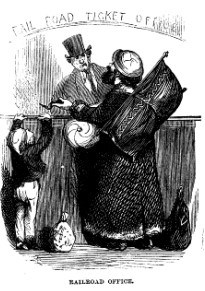
Harper's News Monthly, 1871 The Railroad OfficeThree railroad companies operated out of The Railroad Office; the New York and Erie, the New York Central, and the Pennsylvania Central Railroads. They were the only railways with connections to New York City, and were thus given the privilege to sell tickets at the facility. Railroad agents would ask where an immigrant intended to go, pull out maps and calculate the cost including baggage, and immigrants would pay in full. It was not uncommon to find immigrants short on funds asking for generosity from kind strangers. Others would send messages requesting money from friends or family already in the United States, and would need to wait until the funds arrived by mail in order to pay for their trip.Similar to the Registry Desk, communication at the Railroad Office was also difficult. One reporter noted a particular incident involving a Swedish immigrant who asked to go to Farmington. "...This response was hardly an adequate answer because there were, at that time, some twenty-one cities and villages with that same name in the United States. When asked by a Danish clerk in which state that particular Farmington lay, he had no answer. He had no further address than Farmington, U.S.A. Because most Swedes were far-west travelers, Illinois and Iowa were consequently suggested; but he was still at a loss. Finally, he remembered something about ‘Da’ or ‘Dada’ or ‘Dakota’; and it was found to be ‘Farmington, Dakota County, Minnesota,’ a fact that proved correct by letters he afterward produced from his trunk.”
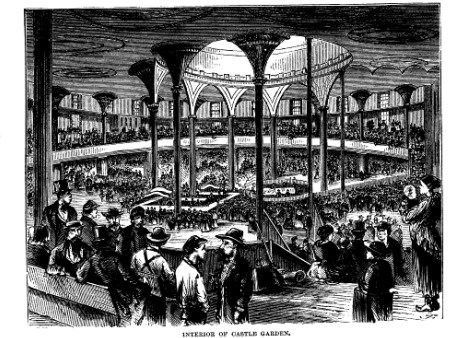
Harper's News Monthly, 1871 The RotundaAfter immigrants were finished in the rotunda, they were free to explore around the facility. The Emigrant Depot retained much of the detail and structures of the Castle Garden Opera House, with lighting fixtures, ornate details on supporting columns, and even much of the second floor balcony remaining remarkably untouched. The facility had two snack bars, which sold rolls and coffee, and a small restaurant remained open most of the day. Within the rotunda, immigrants would find local missionaries passing out literature to believers and approved boarding house agents advertising their services to the newcomers. Immigrants also had access to an outdoor promenade on the second floor, which ran the length of the walls and had the best view of New York Harbor in the city. Benches were placed around the facility for those intending to wait around, and these often doubled as beds for those unable to find or afford a place to stay. Operating hours for the facility were listed as 8:00 am-5:00 pm, but the facility often remained open later to finish processing the days immigrants.On July 10th, 1876, at around 5:15pm, a fire broke out on the second floor of the rotunda, supposedly started by a Mennonite immigrant carelessly knocking lit ashes out of his pipe. The building ignited fast, while around 300 immigrants were still being processed inside the building. John Lucy, a sailor on the USS Minnesota sitting docked in the harbor, was on leave in Battery Park when he heard the commotion. Rushing into the building through the thick smoke that had filled the rotunda, he led hundreds of immigrants to safety outside the walls. At one point, he is described as jumping in and out of the old embrasures on the walls, which would have been fitted with glass windows at the time. John saved countless lives that day, and for his heroics, he was presented with the Medal of Honor. No one was seriously injured in the accident, but the fire had completely gutted the remains of the old Castle Garden Opera House. The building was rebuilt that November, though the second floor gallery and much loved outdoor promenade was never replaced. 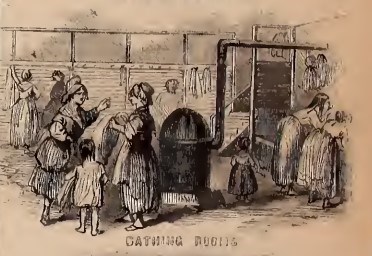
Frank Leslie's Illustrated Newspaper, 1866 Bathing RoomsBefore leaving the rotunda, all immigrants entered the bathing rooms to the left and right of the main exit. They were provided with soap, water, and towels, and were required to wash themselves thoroughly before exiting the building.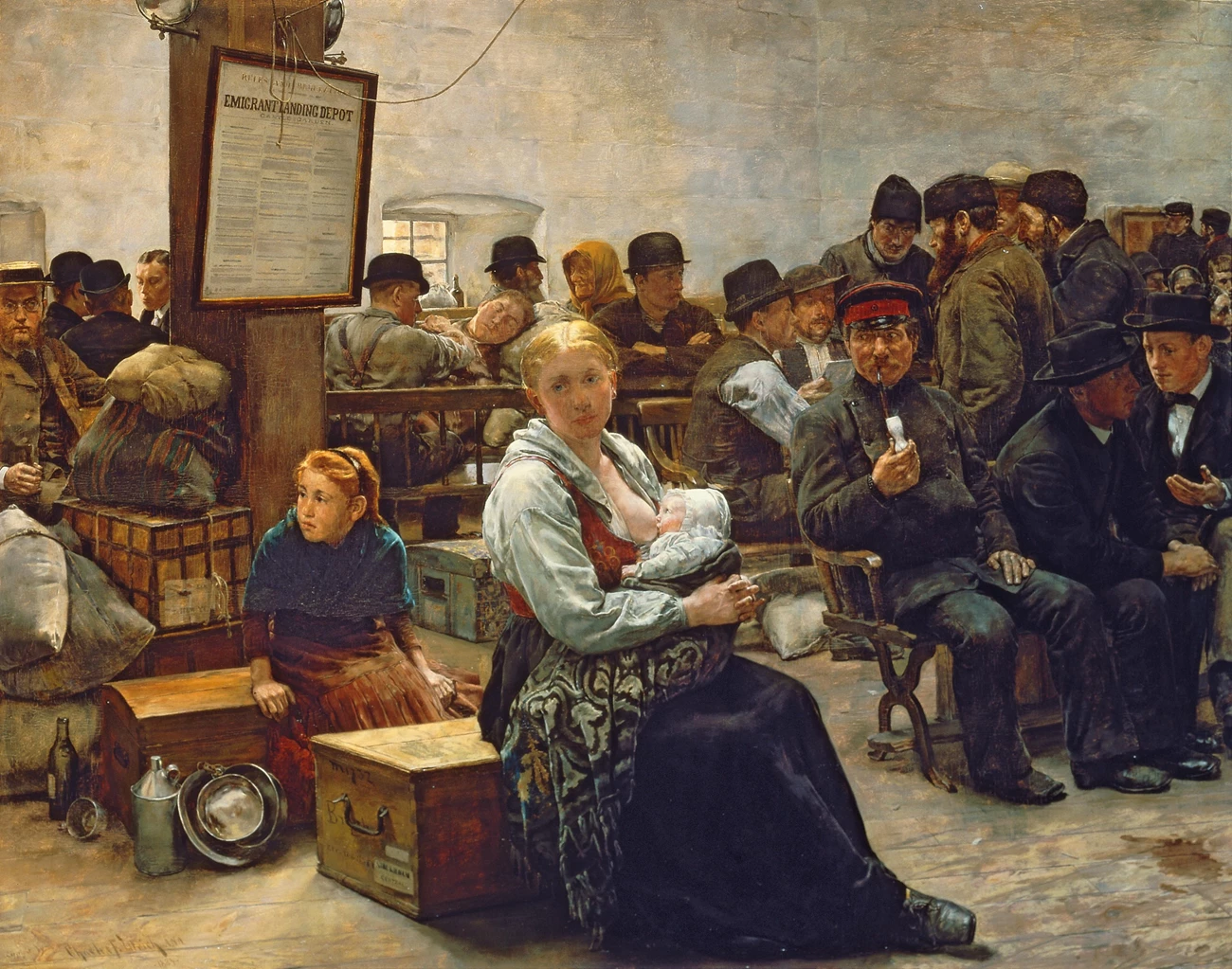
National Gallery of Art
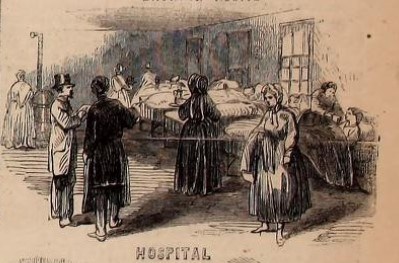
Frank Leslie's Illustrated Newspaper, 1866 Outside the RotundaAs an immigrant exited the rotunda, they came upon a second area of the facility fenced off from the rest of Battery Park. This space contained an information bureau, a small hospital, and the labor bureau. After concluding their business at these locations, immigrants left the facility to begin their new lives in America.The HospitalCastle Garden's Hospital was located to the right of the main entrance and employed two physicians and a surgeon. Their duties involved assisting in inspecting all immmigrants for health issues and providing limited care to those who became sick at the facility. The hospital also received applications for admission to the homeless shelters and medical facilities on Randalls and Wards Islands, and coordinated passage for those approved to enter the facilities.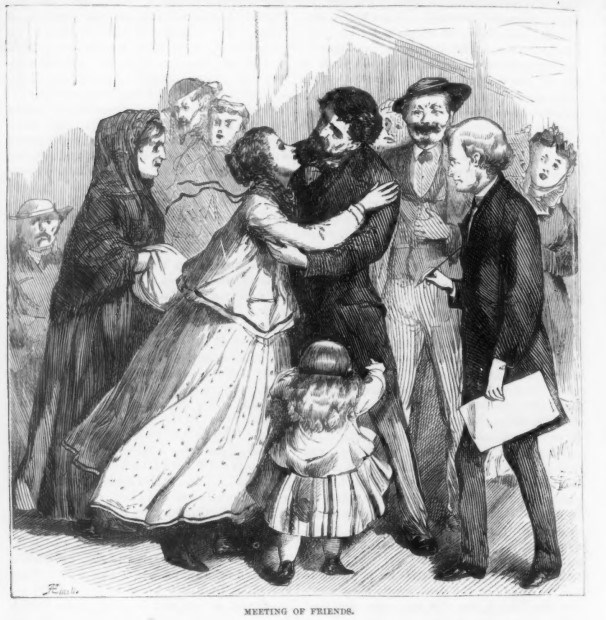
Harper's News Monthly, 1871 Information BureauThe Information Bureau was built around 1866 to provide immigrants with information about New York City and a waiting room where friends and family of immigrants could meet their loved ones. The building was located to the left of the main gate of Castle Garden, and also served as the place for immigrants to find a list of approved boardinghouses for lodging. These lists included daily reports of the number of guests staying in them, reports of Depot officers who had inspected the houses, and all complaints made against the houses.After every immigrant was registered, they were assembled within the Castle Garden rotunda and the names of those with family or friends waiting were called out. At the same time, those with letters or funds waiting for them were directed to the "Forwarding Department." Those who wanted to communicate with friends outside the facility were directed to the "Letter Writing [Bureau]," where multilingual clerks assisted in writing and sending their correspondence. It is unclear where these departments were located in the facility, though it is possible they would have been inside the Information Bureau. 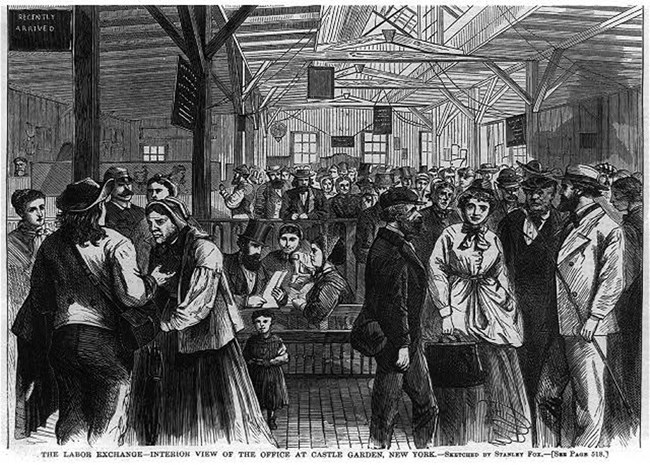
Harper's Weekly, 1868 Labor ExchangeThe Castle Garden Labor Exchange was built in 1867 to help immigrants find work in the city and surrounding area. The Exchange was located on the Depot grounds, next to the hospital, and was built on additional land granted by the city. At the center of the building was a railed off space for officers and employers. Immigrants were separated to either side of the facility based on gender, and subdivided again according to skills, length of residency, and those with and without references. Each immigrant on entering was requested to state their name, ship, date of arrival, and character of employment. Every employer was required to enter their name, residence, recommendations, references, and description of labor wanted.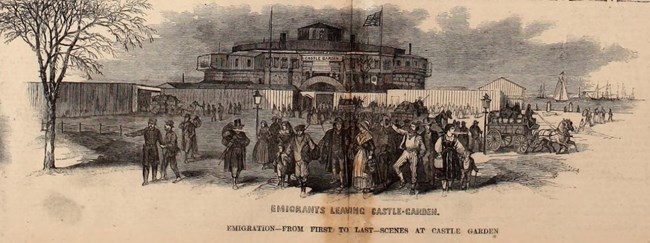
Frank Leslie's Illustrated Newspaper, 1866 Leaving Castle GardenOnce an immigrant was ready to leave the facility, the outer doors of Castle Garden Emigrant Depot would open wide and a large mass would pour through. Awaiting them just outside was Battery Park, where many would take a moment to sit, relax, and take in the moment as they prepared to begin a new life in America.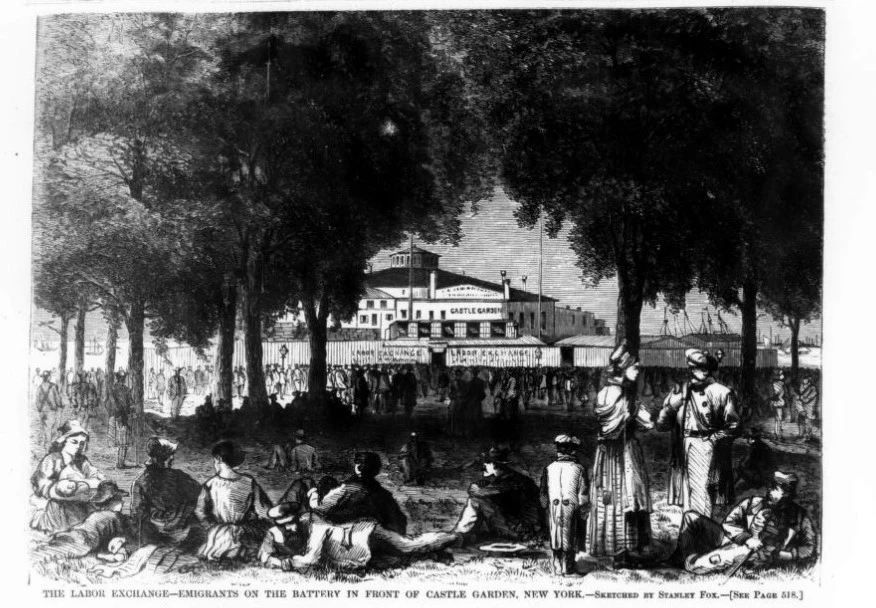
Harper's Magazine 1868
|
Last updated: December 11, 2025
